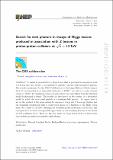Search for dark photons in decays of Higgs bosons produced in association with Z bosons in proton-proton collisions at s$$ \sqrt{s} $$ = 13 TeV
Author(s)
Sirunyan, A. M; Tumasyan, A.; Adam, W.; Ambrogi, F.; Bergauer, T.; Brandstetter, J.; Dragicevic, M.; Erö, J.; Escalante Del Valle, A.; Flechl, M.; Frühwirth, R.; Jeitler, M.; Krammer, N.; Krätschmer, I.; Liko, D.; Madlener, T.; Mikulec, I.; ... Show more Show less
Download13130_2019_Article_11475.pdf (516.4Kb)
Publisher with Creative Commons License
Publisher with Creative Commons License
Creative Commons Attribution
Terms of use
Metadata
Show full item recordAbstract
Abstract
A search is presented for a Higgs boson that is produced in association with a Z boson and that decays to an undetected particle together with an isolated photon. The search is performed by the CMS Collaboration at the Large Hadron Collider using a data set corresponding to an integrated luminosity of 137 fb−1 recorded at a center-of-mass energy of 13 TeV. No significant excess of events above the expectation from the standard model background is found. The results are interpreted in the context of a theoretical model in which the undetected particle is a massless dark photon. An upper limit is set on the product of the cross section for associated Higgs and Z boson production and the branching fraction for such a Higgs boson decay, as a function of the Higgs boson mass. For a mass of 125 GeV, assuming the standard model production cross section, this corresponds to an observed (expected) upper limit on this branching fraction of 4.6 (3.6)% at 95% confidence level. These are the first limits on Higgs boson decays to final states that include an undetected massless dark photon.
Date issued
2019-10-10Department
Massachusetts Institute of Technology. Department of PhysicsPublisher
Springer Berlin Heidelberg
Citation
Journal of High Energy Physics. 2019 Oct 10;2019(10):139
Version: Final published version